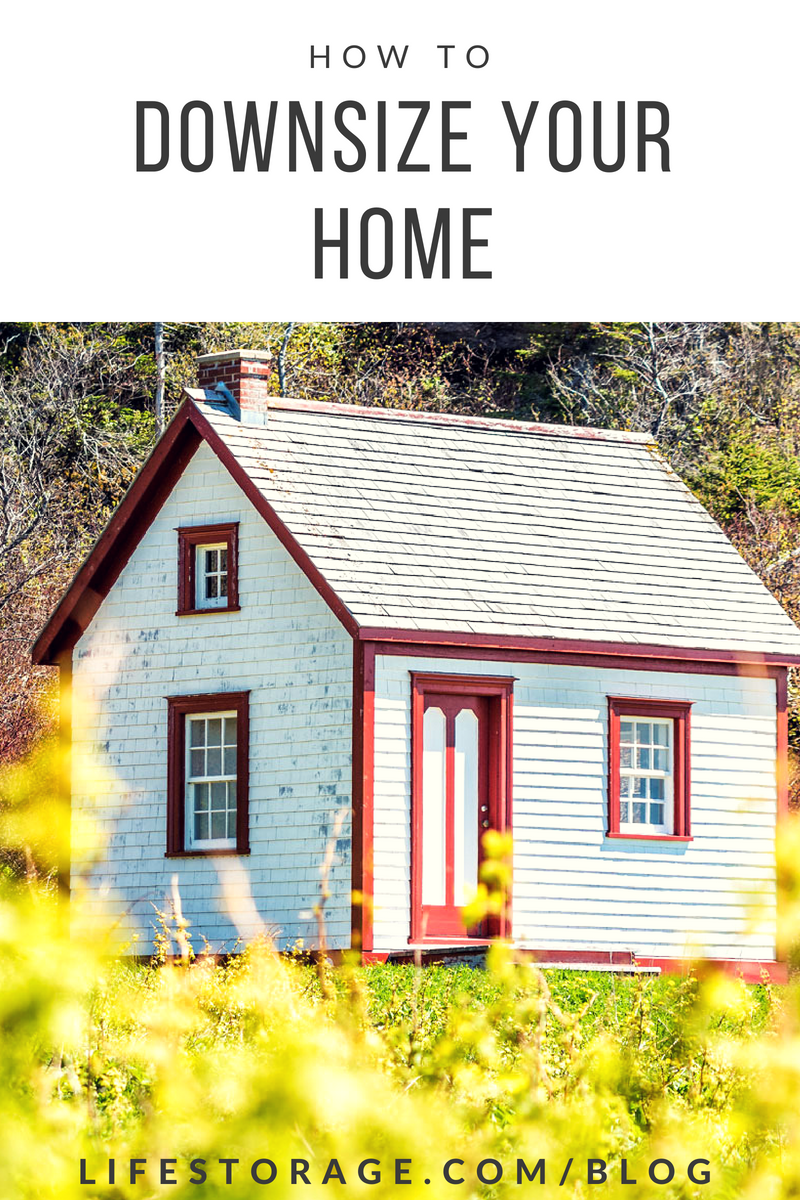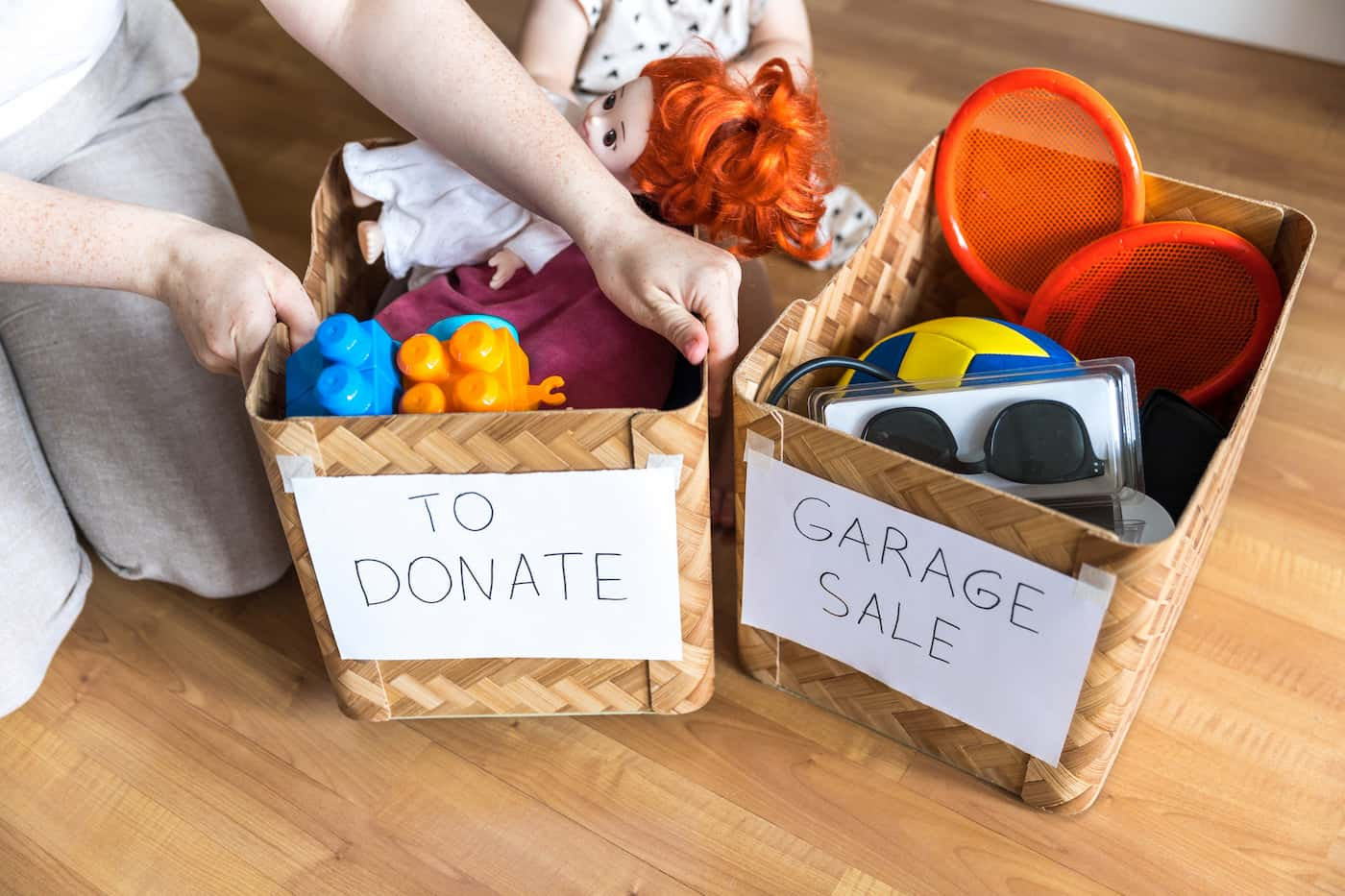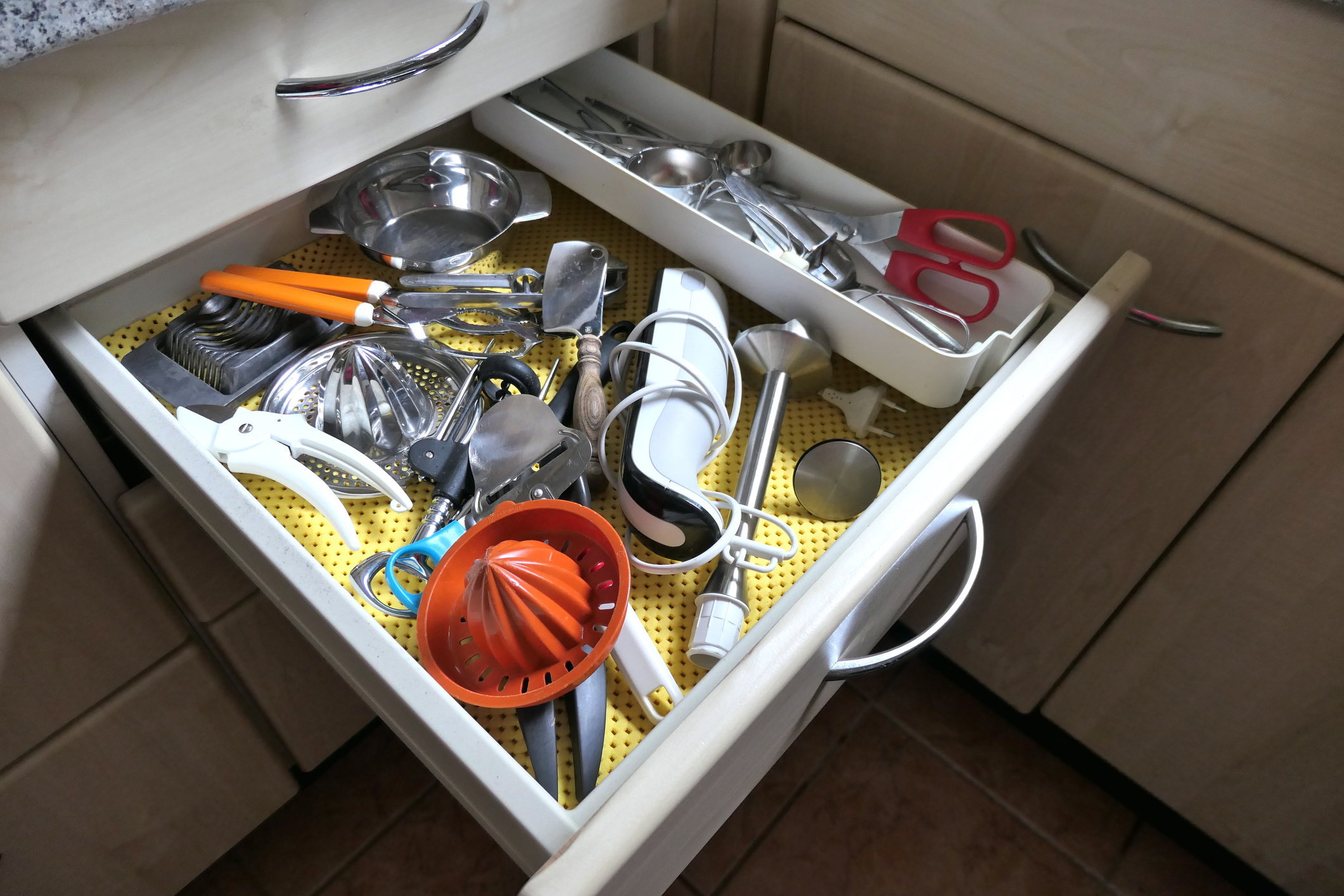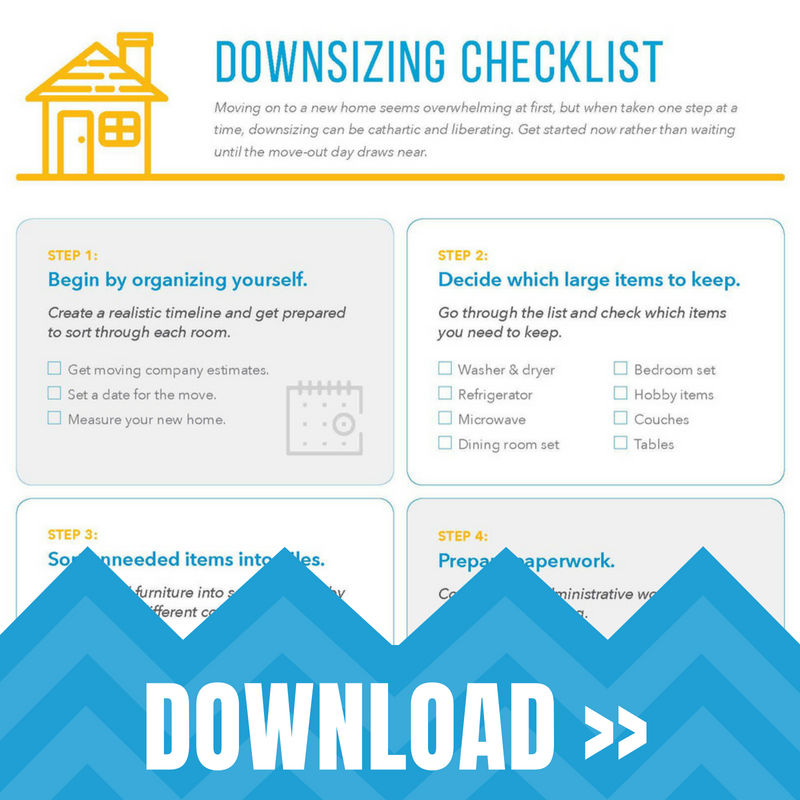
Are you feeling overwhelmed at the thought of moving to a new, smaller place? Maybe you’re relocating to a big city for a new job opportunity. Or, perhaps, you’re trying to sell your house during the recession to take advantage of the housing market while you can. Regardless of your situation, feeling uncertain about downsizing your home is normal.
It’s no secret that moving tops the most stressful life events list. But add downsizing your home and all your belongings into the mix, and things quickly become even more challenging. Not only do you have to face a whole new era in life, you likely have more possessions than you can take when moving to a smaller home, be it an apartment or a condo. Whether you’re an empty nester, downsizing for financial reasons, or simply want less upkeep, being smart about how you downsize is critical.
Related: Moving in Together? 8 Helpful Tips for Living With Your Significant Other for the First Time
How to Downsize for a Move, Step By Step
Luckily, we’ve got plenty of tips (and a free downsizing checklist) for making wise decisions throughout the downsizing process. Here’s your step-by-step guide to paring down, packing smart, and downsizing your home.
Step 1: Make the Big Picture Decisions First
The best (and least overwhelming) way to downsize is to go room by room. Try making big-picture decisions first, then move on to more minor details. Feeling stuck? The following questions will help you think critically about larger or more complicated items. It can also help to discuss things with your partner and/or family before deciding what stays and goes to your new home.
Big Picture Questions to Ask When Downsizing Your Home:
- Does your new place have washer and dryer sets or hookups?
- How important are in-home laundry units to you? Does your new home, apartment complex, or rental property offer on-site washers and dryers?
- Does your new home already have a working refrigerator?
- Is it worth it to you to move heavy appliances? This can include your refrigerator, freezer, stove or oven, and other essentials.
- Consider the cost of hiring a moving company. If you determine they’re necessary, how much are you willing to pay to move heavy appliances?
- Do you have any large sentimental items you’ve inherited that you’ve been holding onto? If so, would you be happier taking them with you, passing them on to family members, or selling them online?
- Will you need a car in your new neighborhood? If not, would you consider walking or taking public transport?
- If having a car is necessary, would you consider downsizing to one shared family vehicle instead of multiple?
These are hard questions, especially if you’re moving into a condo or apartment with limited living and storage space. If you’re moving into a smaller single-family home, you’ll have a little more wiggle room. But either way, these are still important questions that require some extra thought. If you decide to keep items that won’t fit inside your new home, make sure you have enough storage at your new place or consider renting a storage unit near you. Storage units come in a variety of sizes ranging from 5×5 to 10×30, be sure to do your research and pick the right size storage unit for your needs.
Related: How to Save Money on Self-Storage by Finding the Best Deals
Step 2: Develop a Decluttering & Organizing System
Pro tip: Downsizing your home also becomes way more manageable when you start early. You might not be ready to go as far as packing your stuff into moving boxes yet, but you don’t have to wait until the weeks leading up to the move to start decluttering your current space. Whether you plan on hiring a moving company or going the DIY route, less stuff in and around your house means fewer things to worry about when move-in day arrives.
Downsizing Tips: The Four-Pile Sorting System
Here’s an important question people always ask during the downsizing process: What exactly should you do with your stuff when you downsize? After all, you’re sifting through years (maybe even decades) of furniture, appliances, clothing, and other household items. Once you’ve decided what’s staying and going, what’s the best way to discard the things you won’t bring along with you?
 Enter: The four-pile sorting system. Whether you’re still in the early stages of learning how to downsize your home or are already mid-move, this simple organization system can help make the process much easier. As you’re decluttering, create four separate piles for:
Enter: The four-pile sorting system. Whether you’re still in the early stages of learning how to downsize your home or are already mid-move, this simple organization system can help make the process much easier. As you’re decluttering, create four separate piles for:
- Giveaways: These possessions will go to friends and family who can use them.
- Donations: Anything you or your family members don’t want but still has utility can head to a donation center near you.
- Sale items: This pile is optional, but if you’re looking for extra cash (to grease the move or otherwise), this is a simple way to do it.
- Trash pickup or dump: No matter how much we want to think otherwise, some things just don’t have a second life. They go in this pile for a scheduled drop-off or pickup.
A great strategy is to create these piles in distinct corners or even different rooms to keep them completely separate from each other. When you come across possessions that meet one of these descriptions, immediately place them in their designated station so you can dispose of them in batches when you’re ready.
Step 3: Start in Small Spaces
Once you’ve gotten the big-picture decisions and made some headway on the decluttering process, it’s time to start downsizing your home room by room. The four-pile decluttering and organizing system is an excellent method for the entire process. But when it comes to downsizing the physical rooms in your house, where should you start? A great strategy is to start small— literally. You can find some easy wins in those nooks and crannies throughout the house that you’ve long forgotten about. Small spaces that tend to accumulate junk can include:
- Outdoor sheds and garages
- Spare rooms
- Hall Closets
- Out-of-the-way kitchen cabinets
- Linen closets
- Bathroom cabinets or shelves
- Junk drawers
- Attics and crawl spaces
- Kids’ bedrooms
- Smaller sections in basements
Working in smaller spaces of your home also means you’ll be less likely to burn out from moving stress throughout the entire downsizing process. Areas like these can often be tackled in a day or an afternoon; chunking them out one at a time can keep you motivated by helping you feel like you’re making steady progress.
Step 4: Downsize your Furniture Collection Next
Obviously, you’ll need furniture in your new home. The question is: What furniture will fit in your new, smaller home? First, measuring your new space and furniture is important to see if the latter fits. Make sure to account for doorways; sometimes, even if your furniture would fit inside the space, you can’t get it in there to begin with. (Moving a family-sized couch into an apartment through your living room window is doable, but it’s not a fun time.)
If you’re downsizing your home to move into an apartment or condo, chances are you’ll have to part with certain pieces of furniture. Are you having trouble paring things down? Instead of focusing on what to eliminate, set your sights on what you can’t live without or what you would need to replace if it were gone. For example, inherited furniture and family heirlooms that hold sentimental value may be non-negotiable. On the other hand, you may be able to replace your living room sectional for a smaller couch or swap out your L-shaped corner desk for a smaller table or workbench.
Once you’ve narrowed it down, start finding new homes for the furniture that won’t make its way to your new space as soon as possible. That could mean offering them to friends and family, selling or donating them, or tucking them away inside your storage unit.
Related: How to Store Furniture in a Garage or Storage Unit The Right Way
Step 5: Think Through Your Kitchen Items
More than any other room in the home, your kitchen contains items you use every single day. Even your clothes don’t see the type of loyalty you bestow on, say, the cast iron pan you heat up morning, noon, and night.

Downsizing your kitchen might be daunting, but you can approach it with the same strategy as any other room. Don’t focus on what to eliminate. Instead, go through your drawers and pull out the pieces you can’t live without. Maybe that’s the expensive food processor you splurged on, your well-loved pans and silverware, or the air fryer you received as a holiday gift and have used every day since. Remember that it’s okay if your kitchen is disproportionately represented in your piles of moving boxes. (Especially if you like to cook!)
Kitchens are home to everyday odds and ends like can openers, corkscrews, glassware, coffee makers, and other small appliances. However, moving into a smaller home might also mean learning to live with significantly less kitchen space. If that’s the case, these posts may come in handy:
- 15 Helpful Tips to Maximize Kitchen Space
- How To Organize the Kitchen So It’s Easy to Maintain
Step 6: Assess Bedrooms & Living Spaces
Now that you’ve made tough decisions about oversized items, done some serious decluttering, and even pared down your furniture and kitchen items, it’s time to deal with all the other essentials that make a house a home. We’re talking about clothing, books, puzzles, games, toys, blankets, exercise equipment, and more.
Why is it so hard to downsize?
More than anything else, when downsizing, we often get stuck in nostalgia. The macaroni art! The college tee shirts! The art supplies from that oil-on-canvas phase! Decluttering sentimental items can be challenging, to be sure. But with a few targeted questions, you can make much better decisions about what you love versus what you can part with. Check out our list of questions to ask yourself while decluttering sentimental items here.
Related: How to Declutter Your Life in 7 Steps
Regarding paper keepsakes such as special art projects, certificates, and other paper milestones, Gretchen Rubin of The Happiness Project has a brilliant system for filing sentimental items. Whenever she has to sort through papers, she pulls out only the most memorable pieces. This can include things like best-in-class artwork, family photographs, and maybe even a few keepsakes like momentous invitations to weddings, birthdays, and other celebrations. She files the most important papers in a special accordion folder dedicated to the nostalgia and discards the rest.
Rubin also recommends choosing just one representative item for collections. That means one college tee shirt and one snow globe from your every-state-in-the-continental-U.S. snowglobe collection. Think one pair of baby shoes, one item from the costume jewelry you no longer wear, or one amazing trophy from your competitive golf glory days.
Still stuck? Ask if each object “sparks joy,” as Marie Kondo explains in her iconic KonMari method. If you can’t honestly say it adds measurably to your life, let it go. This can be a difficult practice to get used to, but it can really help with the emotional impact of downsizing.
How to Downsize Your Home: A Free Checklist
While downsizing may initially seem frightening, both physically and emotionally, you can make the task much less daunting by breaking it into the above steps. Go ahead and download our free How to Downsize Your Home Checklist right now to help you plan your move and keep you on track. By starting with the big items and getting increasingly granular, you’ll find that you’re left with a more simplified set of possessions— just the right amount for your smaller, new-to-you home.
Related: The Ultimate Moving Checklist + Free Moving Printables Kit
Updated 2/10/23 and 1/17/20 from an article originally published 7/27/2018.








